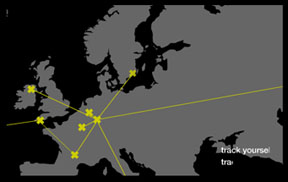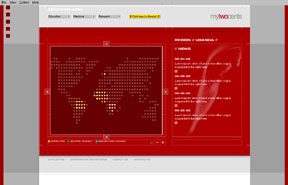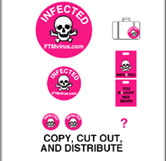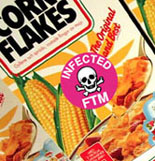PROJECT 40
HAPPENINGText: Matt Owens
The final day was spent presenting the “proof of concept” from each team. Ash Arnett and Peter Cho of Team Three presented a very well articulated online strategy, delivering a presentation that showed how an online initiative combining community, contact information, interactive maps showing the spread of AIDS, and different contribution strategies could be used by a wide range of individuals and institutions to further the cause of AIDs prevention, donations and research. Team One also articulated the use of an email “virus” as a symbolic mechanism that could be used to spread awareness by individuals online. The email virus as a symbolic link to the real virus was an interesting one and was also addressed by Team Two.

David Lai and Mike Abbink of Team One presented a concept site called “My Two Cents” where individuals could donate specific amounts to particular organizations or causes dealing with AIDS. The site would also have an interactive map component so that donators could actually ‘visualize’ where their contributions were going. In addition, affiliate sites like CNN or anyone’s personal homepage could embed the my tow cents donation module, so the effect would occur on a far larger scale than just one Web site. The key idea is that people are willing to donate money but the reasons they usually don’t is because they have no idea where their money goes. This contribution model could also be used for different causes, such as hunger or war relief. The modularity of Team One’s concept was refreshing and everyone agreed that as a project, it was very realistic and doable.

Team Four developed a strategy that worked on a more local and universal level. Tom Roope talked about how the source of an outbreak of yellow fever was pinpointed to a single watermain in London by plotting all of the deaths on a map and looking at their visual arrangement. This same method can be used to plot the spread of AIDS from the first document of HIV in a human in 1959 to the present. By plotting the spread of AIDS cases over time on a global map, a visual representation of the urgency of the AIDS epidemic can be seen on a universal level. Team Three also showed how this visualization could exist as a series of posters, placed in subway stations over time, or also be represented online in a “war games” type format.


Team Two, (my team) was a little unorthodox. Team Two gathered everyone into the main hall at Hyper Island and Simon Waterfall requested that everyone enter the “laboratory.” The laboratory was the 3.5 meter by 3.5 meter men’s rest room on the first floor at Hyper Island. Fitting 40 people into the men’s restroom was by no means easy. After a much pushing and shoving and pressing against one another, everyone was in and the door was shut. A projection was placed on the ceiling, accompanied by loud visceral music. The projection introduced the brief and presented the AIDS epidemic and its staggering numbers. The loud music and confined space was meant to make the group uncomfortable, to feel the closeness and physicality of each other and to in some way reflect the immediacy of the epidemic. The presentation concluded with the introduction of FTM, a virus to a virus. The AIDS crisis has been so publicized over the last 15 years that the word “AIDS” has begun to culturally signify “western culture’s favorite bleeding heart cause.” Polite strategies such as AIDS quilts and 20 K fun runs, while invaluable, no longer speak to the immediacy of the problem in the regions that need it most today. 70% of Aids cases are located in Africa, yet global corporations have the economic power to truly make a difference. In the vein of online campaigns, such as etoys and linex, FTM is a call to arms. It is a confrontational statement to the western world; “Fuck The Man” — infect the most profitable corporations with your opinion and let them know that AIDS is killing millions of people and that they have the economic means to change it. This is what is needed to get corporations and individuals talking and acting in a real way, to shift the economies of scale to truly make a difference. By targeting large corporations (like Phillip Morris, Unilver and Debeers) that exploit individuals and resources inside and outside Africa, FTM stickers on products, food, and through gorilla tactics create an adjunct virus that, because it has no cultural or media baggage and does not say “AIDS,” works to reopen complacent public eyes.
Read more ...




